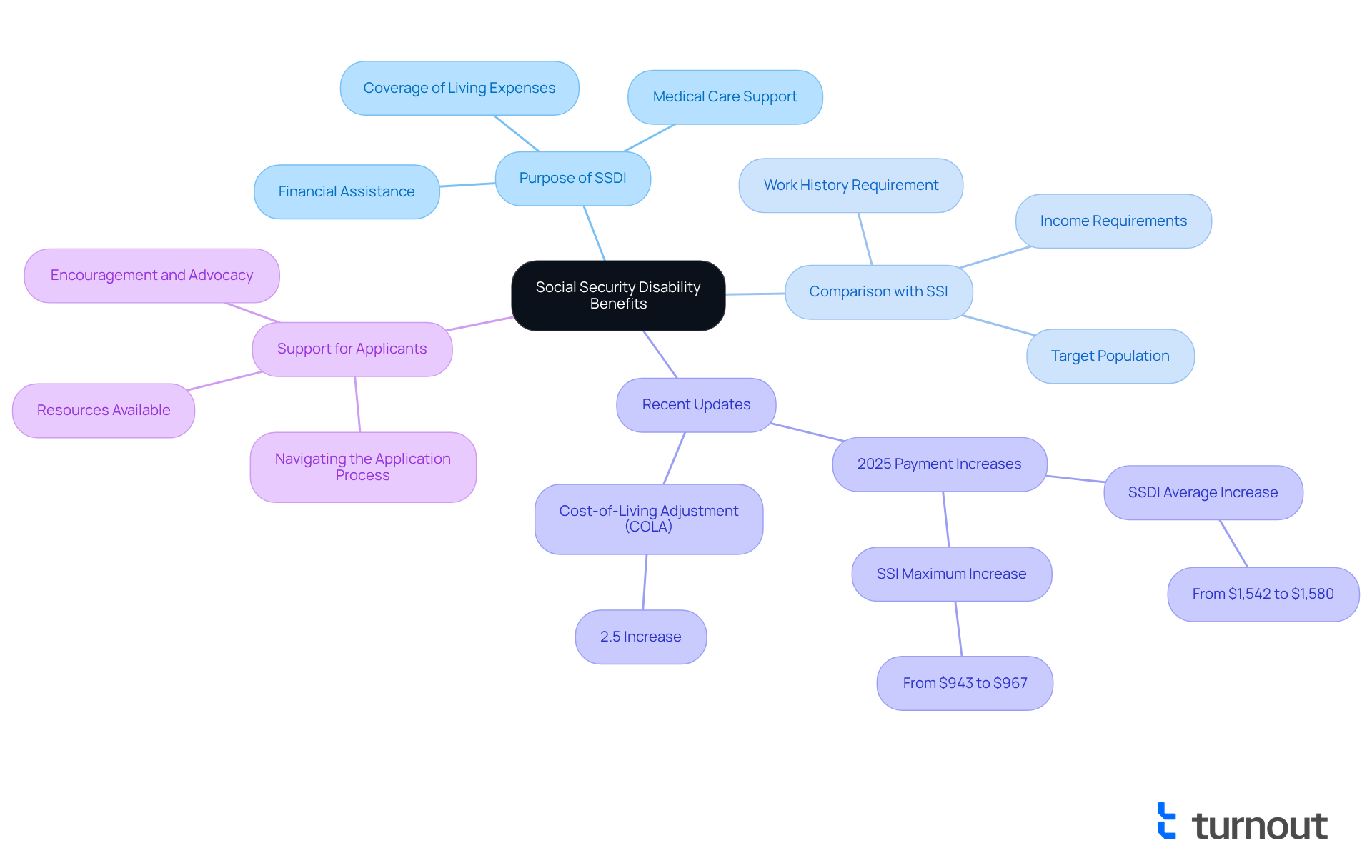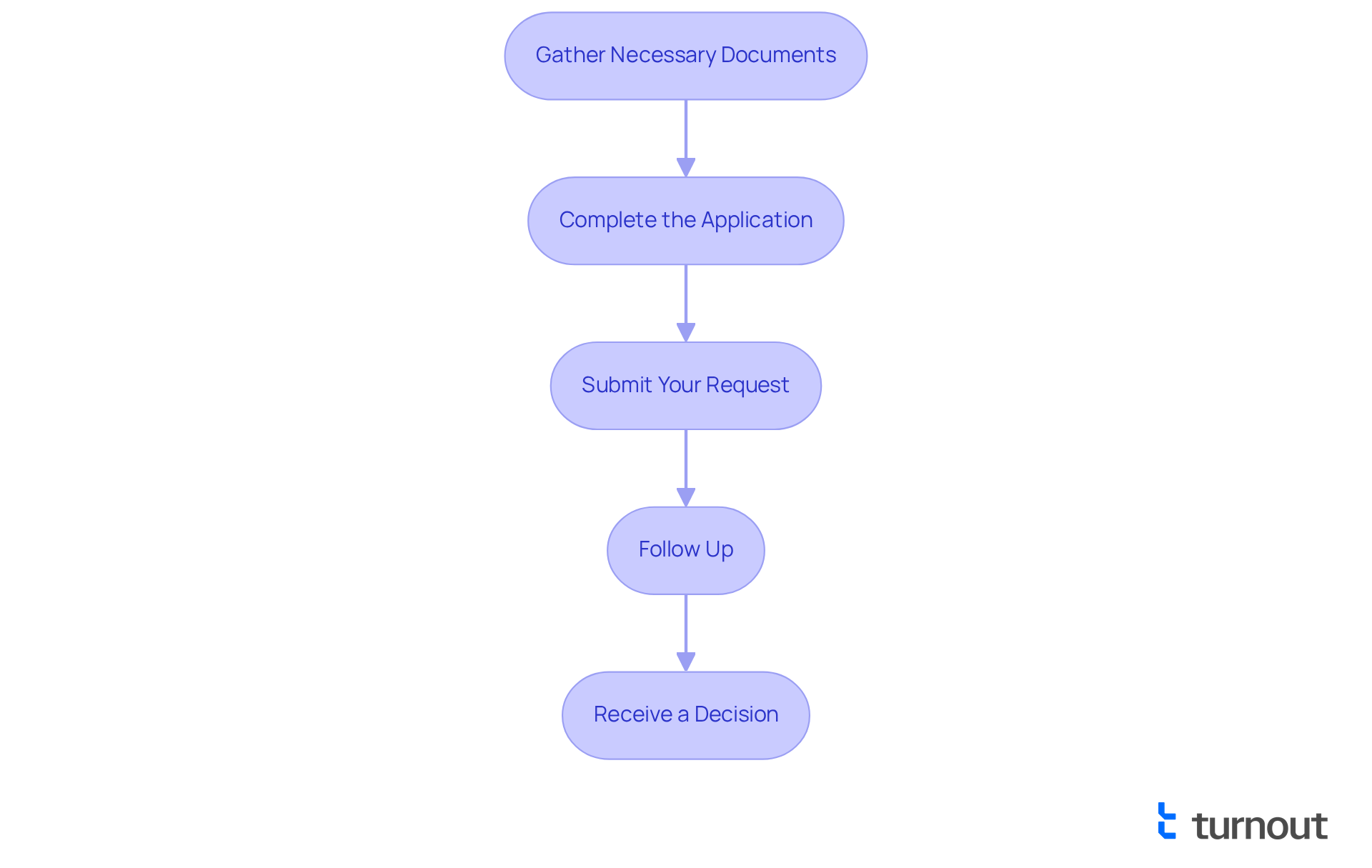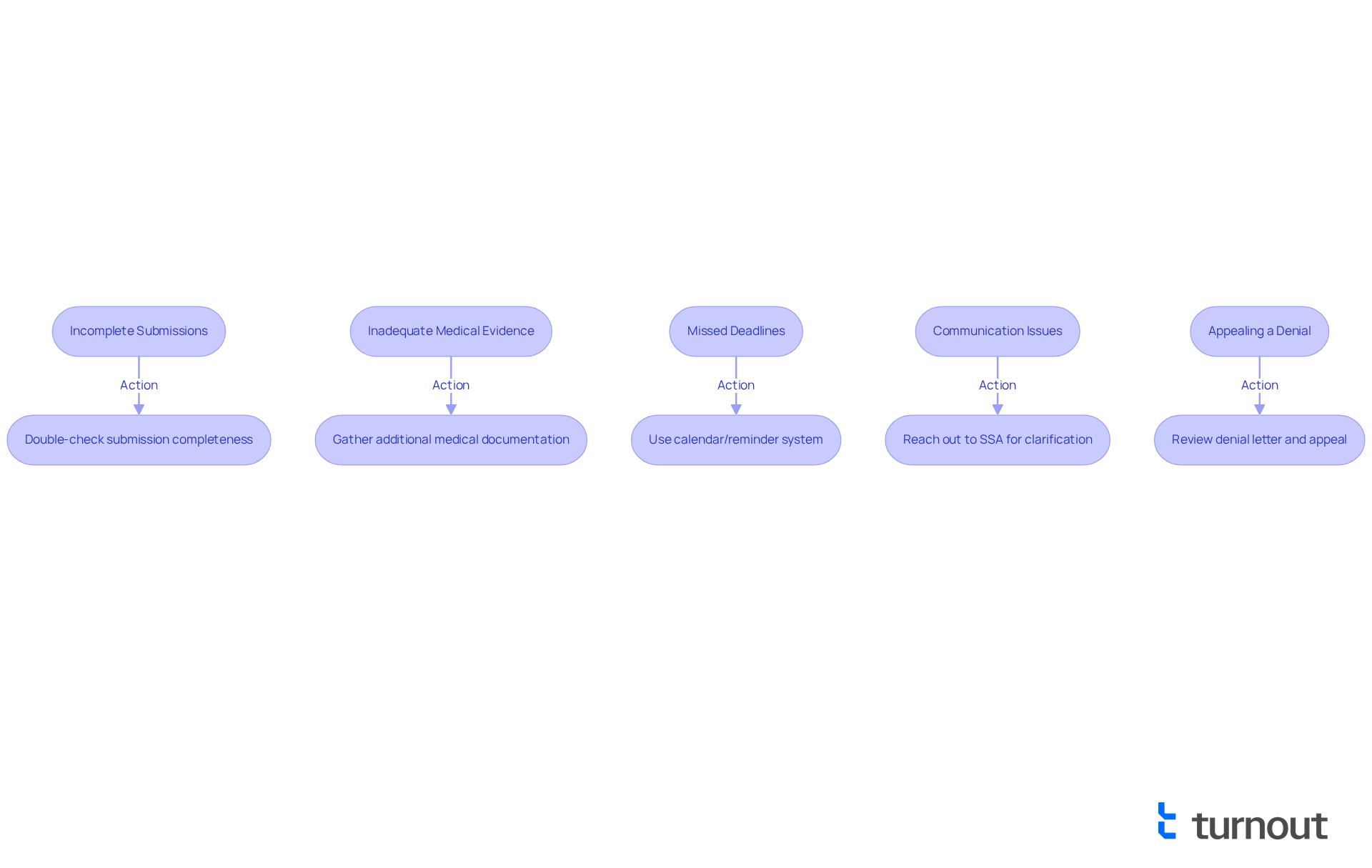Overview
Navigating the process of filing for Social Security Disability Insurance (SSDI) can feel overwhelming, and we understand the challenges you may face. This article serves as a comprehensive step-by-step guide, emphasizing the importance of gathering necessary documents, completing your application accurately, and understanding eligibility requirements.
It's common to encounter pitfalls along the way, such as incomplete submissions and inadequate medical evidence. However, we’re here to help you overcome these obstacles. By detailing common challenges and offering supportive strategies, we aim to empower you to effectively navigate the SSDI application process. Remember, you are not alone in this journey; we are here to support you every step of the way.
Introduction
Navigating the maze of Social Security Disability Insurance (SSDI) can feel overwhelming, especially for the millions who rely on it for financial support during difficult times. We understand that the complexities of eligibility, application processes, and recent updates to benefits can be daunting. It’s crucial for anyone seeking these essential resources to feel informed and empowered.
But what should you do when the process becomes too much to bear, or when you face a denial? This guide is here to help. It not only clarifies the steps to filing for SSDI but also provides you with strategies to overcome common obstacles. Together, we’ll ensure that you can advocate effectively for your rights and needs, reminding you that you are not alone in this journey.
Understand Social Security Disability Benefits
Social Security Disability Insurance provides essential financial assistance to individuals who are unable to work due to qualifying disabilities. Unlike welfare programs, this insurance scheme is financed through payroll taxes, ensuring that those who have contributed to the system receive support when they need it most. Assistance from Social Security Disability Insurance can help cover vital living expenses, medical care, and other critical needs.
We understand that navigating the complexities of these programs can be overwhelming. It's crucial to recognize the distinctions between Social Security Disability Insurance and Supplemental Security Income (SSI). While Social Security Disability Insurance is based on work history and contributions, SSI is designed for low-income individuals, including those with disabilities, who may not have sufficient work history. Approximately 68 million Americans rely on these programs, yet many remain unaware of the specific benefits available to them.
Recent updates to the disability and supplemental security income programs are significant and worth noting. For instance, in 2025, disability recipients will see an average monthly payment increase from $1,542 to an estimated $1,580, reflecting a 2.5% cost-of-living adjustment (COLA). This adjustment is vital for helping individuals cope with rising living costs due to inflation. Similarly, SSI recipients will experience an increase in their maximum monthly payout from $943 to $967.
Real-world examples highlight the impact of SSDI. Many individuals have successfully navigated the enrollment process by learning how to file social security disability, obtaining assistance that has allowed them to maintain a consistent standard of living despite their disabilities. By understanding how to file social security disability benefits, you can better prepare for the application process and effectively advocate for your rights. Remember, you're not alone in this journey; we’re here to help you every step of the way.

Determine Your Eligibility for Benefits
To qualify for Social Security Disability Insurance (SSDI) assistance, we understand how to file social security disability can feel overwhelming. First, it’s important to know that you need to have accumulated enough activity credits—typically totaling 40—with at least 20 earned in the last 10 years before your disability onset. In 2025, you should be aware that the Substantial Gainful Activity (SGA) income limit is expected to increase, allowing beneficiaries like you to earn more before your benefits are affected.
Secondly, your medical condition must align with the Social Security Administration's (SSA) definition of disability. This means your condition should significantly hinder your ability to carry out fundamental activities. For a comprehensive understanding of qualifying conditions, we encourage you to refer to the SSA's Blue Book, which details the medical criteria necessary for approval.
Gathering thorough documentation is crucial, including your work history and medical records, to substantiate your claim. If you have doubts about your eligibility, remember that seeking help from a disability support advocate can provide tailored advice on how to file social security disability, enhancing your likelihood of a successful application. Additionally, staying informed about legislative changes is vital, as these can impact your benefits.
It’s common to feel discouraged if your claim is denied, but you have the right to appeal. Understanding the structured appeal process can be beneficial, and remember, you are not alone in this journey. We’re here to help you through every step.

Follow the Application Process Step-by-Step
-
Gather Necessary Documents: We understand that starting this process can feel overwhelming. Begin by assembling vital records such as your Social Security number, birth certificate, and a detailed employment history. Most importantly, ensure your medical records clearly detail your disability and include information on how to file social security disability based on how it affects your ability to perform tasks. Supporting documentation should include clinic visit notes, imaging studies, lab test results, and psychological evaluations, as these are crucial for substantiating your claim. Remember, the SSA gives more weight to notes from specialists compared to those from general practitioners, so prioritize obtaining those if available.
-
Complete the Application: It's common to feel uncertain about where to start. You can apply for SSDI online at the SSA website, by phone, or in person at your local Social Security office. Be sure to complete the forms, including SSA-16 and SSA-3368, with detailed information about your medical condition and work history. It's important to recognize that you have the right to representation throughout the submission process when you learn how to file social security disability, which can help ensure your request is as robust as possible.
-
Submit Your Request: Once your request is complete, submit it along with all required documentation. We encourage you to maintain duplicates of everything you send, as this will assist you in monitoring your submission and responding to any inquiries for further details.
-
Follow Up: After submission, actively monitor the status of your request. You can check your status through your Social Security account dashboard or by contacting the SSA directly. Be prepared to provide any additional information they may request during the review process. Remember, staying informed can help ease your anxiety.
-
Receive a Decision: The SSA will assess your request and inform you of their decision, usually within 3 to 6 months. If approved, you will receive information regarding your benefits, including the start date, which can be up to four months after your submission date. If your request is denied, please know that you have the right to contest the decision, beginning with a plea for reconsideration within 60 days. There are four levels of appeal available if you disagree with the SSA's decision, so be aware of your options. You're not alone in this journey, and we’re here to help you navigate through it.

Troubleshoot Common Application Issues
-
Incomplete Submissions: Many SSDI candidates face challenges due to incomplete submissions, which can lead to delays or even denials. It's common to feel overwhelmed—over 30% of applicants encounter issues related to this. To help prevent this, ensure that every part of your submission is thoroughly filled out. Before sending, take a moment to double-check your submission to confirm that all required information is included.
-
Inadequate Medical Evidence: Unfortunately, numerous requests are rejected due to a lack of adequate medical evidence. If your request is denied for this reason, we encourage you to promptly gather additional documentation from your healthcare providers. This should include updated medical records, treatment plans, and detailed statements from your doctors that clearly outline your condition and its impact on your daily life.
-
Missed Deadlines: Keeping track of deadlines is crucial in the SSDI submission process. We understand that life can get busy, so using a calendar or reminder system can be helpful to ensure that you submit all required documents on time. Missing deadlines can significantly hinder your chances of approval, especially with the current backlog of over 1 million claims at the SSA.
-
Communication Issues: Open communication with the Social Security Administration (SSA) is vital. If you have questions or need clarification about your submission, please don't hesitate to reach out. As noted by disability advocates, maintaining clear lines of communication can help resolve issues quickly and efficiently.
-
Appealing a Denial: If your application is denied, take a moment to carefully review the denial letter to understand the reasons behind the decision. Remember, you have the right to appeal by submitting a request for reconsideration within 60 days of receiving the denial. Seeking assistance from a disability benefits advocate can be immensely beneficial, as they can help strengthen your appeal by ensuring that all necessary documentation is included and that your case is presented effectively.

Conclusion
Understanding how to file for Social Security Disability benefits is a crucial step for individuals facing the challenges of qualifying disabilities. We recognize that this journey can feel overwhelming. However, this guide has illuminated the path to accessing vital financial support, emphasizing the importance of being informed and prepared throughout the application process.
Key insights have been shared, including:
- The distinctions between Social Security Disability Insurance and Supplemental Security Income
- Eligibility requirements
- The step-by-step application process
It's common to feel uncertain about these details, but rest assured, practical tips for troubleshooting issues like incomplete submissions and inadequate medical evidence have been provided. This ensures that applicants can navigate potential pitfalls effectively. Recent updates on benefit amounts and adjustments for inflation further underscore the importance of staying informed.
Ultimately, the journey toward securing Social Security Disability benefits may seem daunting, but understanding the process can empower you to advocate for your rights. By taking the necessary steps and seeking assistance when needed, you can enhance your chances of a successful application. Remember, this knowledge not only represents a pathway to financial stability but also affirms that support is available for those who need it most. You are not alone in this journey; we're here to help.
Frequently Asked Questions
What is Social Security Disability Insurance (SSDI)?
Social Security Disability Insurance provides financial assistance to individuals who are unable to work due to qualifying disabilities. It is financed through payroll taxes and supports those who have contributed to the system.
How does SSDI differ from Supplemental Security Income (SSI)?
SSDI is based on work history and contributions, while SSI is designed for low-income individuals, including those with disabilities, who may not have sufficient work history.
How many people rely on Social Security disability programs?
Approximately 68 million Americans rely on Social Security disability programs.
What recent updates have been made to disability and SSI programs?
In 2025, disability recipients will see an average monthly payment increase from $1,542 to an estimated $1,580, reflecting a 2.5% cost-of-living adjustment (COLA). SSI recipients will see an increase in their maximum monthly payout from $943 to $967.
How can SSDI assist individuals with disabilities?
SSDI can help cover vital living expenses, medical care, and other critical needs, allowing individuals to maintain a consistent standard of living despite their disabilities.
What resources are available for individuals navigating the SSDI application process?
There are resources available to help individuals learn how to file for Social Security disability benefits, ensuring they are prepared for the application process and can effectively advocate for their rights.




